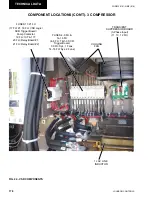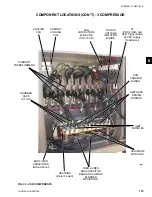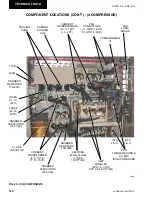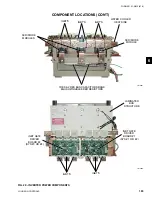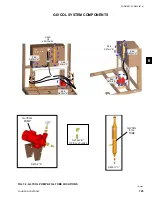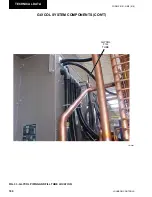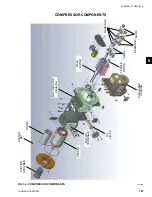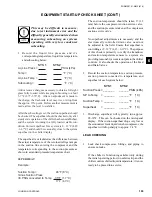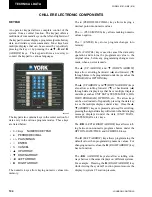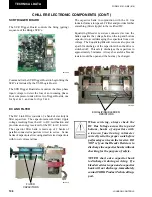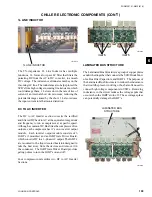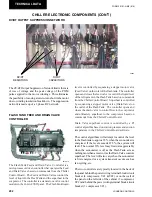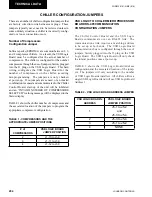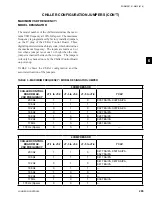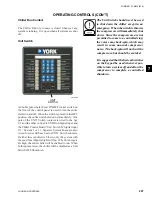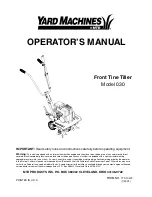
192
JOHNSON CONTROLS
FORM 201.21-NM3 (616)
TECHNICAL DATA
CHECKING SUBCOOLING AND SUPERHEAT
The subcooling should always be checked when
charging the system with refrigerant and/or before
EQUIPMENT START-UP CHECK SHEET (CON'T)
checking the superheat. The subcooling measurement
should always be taken with the system loaded, the
economizer solenoid energized, and the level in the flash
tank reasonably stable with a level of approximately
35%.
It may be desirable to check subcooling
with one compressor running to allow
the compressor to operate at full speed
for a period of time to stabilize system
temperatures and pressures.
When the refrigerant charge is correct, there will be
no bubbles in the liquid sight glass with the system
operating under full load conditions, and there will be 5
- 7°F (2.77 - 3.78°C) subcooled liquid leaving the con-
denser. YCAV0157's should have subcooling set at 10°F
(5.56°C). An overcharged system should be guarded
against. Evidence of overcharge are as follows:
a. If a system is overcharged, the discharge pressure
will be higher than normal. (Normal discharge/con-
densing pressure can be found in the refrigerant tem-
perature/pressure chart; use entering air temperature
+30°F (17°C) for normal condensing temperature.
b. The temperature of the liquid refrigerant out of the
condenser should be about 5-7°F
(2.77 - 3.78°C)
less
than the condensing temperature (The temperature
corresponding to the condensing pressure from the
refrigerant temperature/pressure chart).
The subcooling temperature of each system should be
calculated by recording the temperature of the liquid
line at the outlet of the condenser and subtracting it
from the recorded liquid line pressure at the liquid stop
valve, converted to temperature from the temperature/
pressure chart.
SUBCOOLING
Example:
Liquid line pressure =
110 PSIG converted to
93
°
F (33.9
°
C)
Minus liquid line temp.
-87
°
F (30.6
°
C)
SUBCOOLING =
6
°
F (3.3
°
C)
The subcooling should be adjusted to 5 – 7
°
F (2.77
– 3.78
°
C)
14. Place the panel in Service mode and turn on each
fan stage one by one. Assure the fans rotate in the
correct direction, so air flow exits the top of the
chiller.
15. Remove the cap on the fill tube and run the glycol
pump to verify the level in the fill tube. Assure
the glycol level in the VSD cooling system is 9-
15 inches (23-28 cm) from the top of the fill tube
while running. The pump can be run by placing the
chiller in the SERVICE mode (Page 296). Be sure
to re-install the cap before stopping the glycol pump
to avoid overflowing the fill tube when the glycol
pump is turned off. The glycol system holds about
3.5 gallons of coolant on the largest YCAS0267.
INITIAL START-UP
After the control panel has been programmed and the
compressor heaters have been energized for at least 8
hours (ambient temperature > 96ºF (36ºC)) or 24 hours
(ambient temperature < 86ºF (30ºC)), the chiller may
be placed in operation.
1. Turn on the UNIT SWITCH and program the System
Switches on the Keypad to the "ON" position.
2. If cooling demand permits, the compressor(s) will
start and a flow of refrigerant will be noted in the
sight glass, after the anti recycle timer times out and
the precharge of the DC Bus is completed. After
several minutes of operation, the bubbles in the sight
glass will disappear and there will be a solid column
of liquid when the drain and feed valves stabilize
the flash tank level.
3. Allow the compressor to run a short time, being
ready to stop it immediately if any unusual noise or
adverse conditions develop. Immediately at start-up,
the compressor may make sounds different from
its normal high-pitched sound. This is due to the
compressor coming up to speed and the initial lack
of an oil film sealing the clearances in the rotors.
This should be of no concern and lasts for only a
short time.
4. Check the system operating parameters. Do this
by selecting various displays such as pressures and
temperatures. Compare these to test gauge
readings.
Summary of Contents for YCAV0267E
Page 61: ...61 JOHNSON CONTROLS FORM 201 21 NM3 616 This intentionally left blank 6 ...
Page 73: ...73 JOHNSON CONTROLS FORM 201 21 NM3 616 This page intentionally left blank 6 ...
Page 89: ...89 JOHNSON CONTROLS FORM 201 21 NM3 616 6 035 20890 009 REV LOCATION LABEL CON T LD11141 ...
Page 146: ...146 JOHNSON CONTROLS FORM 201 21 NM3 616 TECHNICAL DATA This page intentionally left blank ...
Page 147: ...147 JOHNSON CONTROLS FORM 201 21 NM3 616 6 This page intentionally left blank ...
Page 247: ...247 JOHNSON CONTROLS FORM 201 21 NM3 616 This page intentionally left blank ...
Page 269: ...269 JOHNSON CONTROLS FORM 201 21 NM3 616 This page intentionally left blank 8 ...
Page 289: ...289 JOHNSON CONTROLS FORM 201 21 NM3 616 8 This page intentionally left blank ...
Page 317: ...317 JOHNSON CONTROLS FORM 201 21 NM3 616 8 This page intentionally left blank ...
Page 348: ...348 JOHNSON CONTROLS FORM 201 21 NM3 616 MAINTENANCE NOTES ...
Page 349: ...349 JOHNSON CONTROLS FORM 201 21 NM3 616 9 NOTES ...

